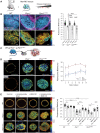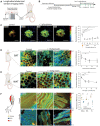Monitoring AKT activity and targeting in live tissue and disease contexts using a real-time Akt-FRET biosensor mouse
- PMID: 37126544
- PMCID: PMC10132756
- DOI: 10.1126/sciadv.adf9063
Monitoring AKT activity and targeting in live tissue and disease contexts using a real-time Akt-FRET biosensor mouse
Abstract
Aberrant AKT activation occurs in a number of cancers, metabolic syndrome, and immune disorders, making it an important target for the treatment of many diseases. To monitor spatial and temporal AKT activity in a live setting, we generated an Akt-FRET biosensor mouse that allows longitudinal assessment of AKT activity using intravital imaging in conjunction with image stabilization and optical window technology. We demonstrate the sensitivity of the Akt-FRET biosensor mouse using various cancer models and verify its suitability to monitor response to drug targeting in spheroid and organotypic models. We also show that the dynamics of AKT activation can be monitored in real time in diverse tissues, including in individual islets of the pancreas, in the brown and white adipose tissue, and in the skeletal muscle. Thus, the Akt-FRET biosensor mouse provides an important tool to study AKT dynamics in live tissue contexts and has broad preclinical applications.
Figures







References
-
- M. Whitman, D. R. Kaplan, B. Schaffhausen, L. Cantley, T. M. Roberts, Association of phosphatidylinositol kinase activity with polyoma middle-T competent for transformation. Nature 315, 239–242 (1985). - PubMed
-
- K. M. Nicholson, N. G. Anderson, The protein kinase B/Akt signalling pathway in human malignancy. Cell. Signal. 14, 381–395 (2002). - PubMed
-
- J. R. W. Conway, S. C. Warren, D. Herrmann, K. J. Murphy, A. S. Cazet, C. Vennin, R. F. Shearer, M. J. Killen, A. Magenau, P. Mélénec, M. Pinese, M. Nobis, A. Zaratzian, A. Boulghourjian, A. M. Da Silva, G. del Monte-Nieto, A. S. A. A. Adam, R. P. Harvey, J. J. Haigh, Y. Wang, D. R. Croucher, O. J. Sansom, M. Pajic, C. E. Caldon, J. P. Morton, P. Timpson, Intravital imaging to monitor therapeutic response in moving hypoxic regions resistant to PI3K pathway targeting in pancreatic cancer. Cell Rep. 23, 3312–3326 (2018). - PMC - PubMed
MeSH terms
Substances
Grants and funding
LinkOut - more resources
Full Text Sources
Molecular Biology Databases

